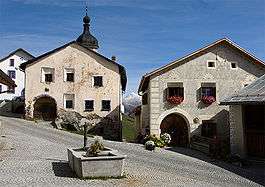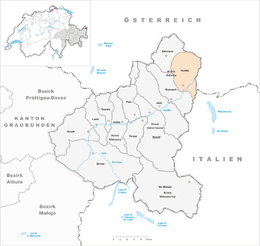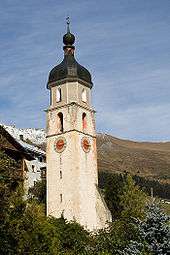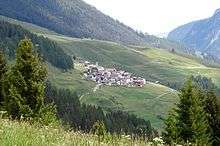Tschlin
| Tschlin | ||
|---|---|---|
| Former municipality of Switzerland | ||
 | ||
| ||
 Tschlin  Tschlin | ||
|
Location of Tschlin  | ||
| Coordinates: 46°52′N 10°25′E / 46.867°N 10.417°ECoordinates: 46°52′N 10°25′E / 46.867°N 10.417°E | ||
| Country | Switzerland | |
| Canton | Graubünden | |
| District | Inn | |
| Area | ||
| • Total | 75.08 km2 (28.99 sq mi) | |
| Elevation | 1,553 m (5,095 ft) | |
| Population (Dec 2011) | ||
| • Total | 442 | |
| • Density | 5.9/km2 (15/sq mi) | |
| Postal code | 7559 | |
| SFOS number | 3753 | |
| Localities | Tschlin, Martina (includes Vinadi) and Strada (includes Chaflur) | |
| Surrounded by | Graun im Vinschgau (IT-BZ), Nauders (AT-7), Pfunds (AT-7), Samnaun, Spiss (AT-7) | |
| Website |
www SFSO statistics | |
Tschlin is a former municipality in the district of Inn in the canton of Graubünden in the extreme east of Switzerland. On 1 January 2013 the municipalities of Ramosch and Tschlin merged to form the new municipality of Valsot.[1]
History

While Bronze and Iron Age items have been found in Tschlin, the first mention of the village is in the 10th Century. In the 10th Century, bishop Hildibald gave the chapterhouse in Chur a gift of a farm house in Tschlin. In the High Middle Ages Tschlin was under the authority of Ramosch. The village church of St. Blasius was built in 1515 in the gothic style. In 1545 the Protestant Reformation reached the village and in 1574-82 the reformer and historian Ulrich Campell worked in Tschlin. In 1856 a fire destroyed much of the village, including the Church of St. John the Baptist. The church was not rebuilt, but the church tower is still visible in the village.[2]
Geography

Tschlin had an area, as of 2006, of 75.1 km2 (29.0 sq mi). Of this area, 28.7% is used for agricultural purposes, while 34.7% is forested. Of the rest of the land, 1.3% is settled (buildings or roads) and the remainder (35.3%) is non-productive (rivers, glaciers or mountains).[3]
The former municipality is located in the Ramosch sub-district of the Inn district. It consists of the village of Tschlin on a terrace above the left bank of the Inn, the sections of Strada and Martina and the hamlets of San Niclà, Chaflur, Sclamischot and Vinadi.
Until 1943 Tschlin was known as Schleins.[1]
Demographics
Tschlin had a population (as of 2011) of 442.[4] As of 2008, 6.3% of the population was made up of foreign nationals.[5] Over the last 10 years the population has grown at a rate of 1.8%.[3]
As of 2000, the gender distribution of the population was 49.6% male and 50.4% female.[6] The age distribution, as of 2000, in Tschlin is; 39 children or 9.9% of the population are between 0 and 9 years old. 27 teenagers or 6.9% are 10 to 14, and 14 teenagers or 3.6% are 15 to 19. Of the adult population, 42 people or 10.7% of the population are between 20 and 29 years old. 59 people or 15.1% are 30 to 39, 54 people or 13.8% are 40 to 49, and 48 people or 12.2% are 50 to 59. The senior population distribution is 37 people or 9.4% of the population are between 60 and 69 years old, 55 people or 14.0% are 70 to 79, there are 16 people or 4.1% who are 80 to 89, and there are 1 people or 0.3% who are 90 to 99.[5]
In the 2007 federal election the most popular party was the SVP which received 48.9% of the vote. The next three most popular parties were the SPS (20.8%), the FDP (14.3%) and the CVP (13.6%).[3]
In Tschlin about 62.8% of the population (between age 25-64) have completed either non-mandatory upper secondary education or additional higher education (either university or a Fachhochschule).[3]
Tschlin has an unemployment rate of 0.81%. As of 2005, there were 62 people employed in the primary economic sector and about 24 businesses involved in this sector. 28 people are employed in the secondary sector and there are 8 businesses in this sector. 101 people are employed in the tertiary sector, with 21 businesses in this sector.[3]
The historical population is given in the following table:[2][6]
| year | population |
|---|---|
| 1835 | 665 |
| 1850 | 571 |
| 1900 | 553 |
| 1930 | 648 |
| 1950 | 590 |
| 1960 | 553 |
| 1970 | 499 |
| 1980 | 431 |
| 1990 | 515 |
| 2000 | 392 |
| 2010 | 448 |
Languages
Most of the population (as of 2000) speaks Rhaeto-Romance (71.4%), with German being second most common (25.5%) and Serbo-Croatian being third ( 1.0%).[3]
| Languages in Tschlin | ||||||
| Languages | Census 1980 | Census 1990 | Census 2000 | |||
| Number | Percent | Number | Percent | Number | Percent | |
| German | 64 | 14.85% | 130 | 25.24% | 100 | 25.51% |
| Romanish | 362 | 83.99% | 313 | 60.78% | 280 | 71.43% |
| Italian | 4 | 0.93% | 33 | 6.41% | 3 | 0.77% |
| Population | 431 | 100% | 515 | 100% | 392 | 100% |
Heritage sites of national significance
The Museum Stamparia da Strada is listed as a Swiss heritage site of national significance.[7]
References
- 1 2 Amtliches Gemeindeverzeichnis der Schweiz published by the Swiss Federal Statistical Office (in German) accessed 2 January 2013
- 1 2 Tschlin in German, French and Italian in the online Historical Dictionary of Switzerland.
- 1 2 3 4 5 6 Swiss Federal Statistical Office accessed 12-Oct-2009
- ↑ Swiss Federal Statistics Office – STAT-TAB Ständige und Nichtständige Wohnbevölkerung nach Region, Geschlecht, Nationalität und Alter (in German) accessed 3 October 2012
- 1 2 Graubunden Population Statistics (in German) accessed 21 September 2009
- 1 2 Graubunden in Numbers (in German) accessed 21 September 2009
- ↑ Swiss inventory of cultural property of national and regional significance 21.11.2008 version, (in German) accessed 12-Oct-2009
| Wikimedia Commons has media related to Tschlin. |
